John Watson Book Reviews (100)
History and General Works Part 5. John Watson Book Review #100
IM John Watson - Wednesday 9th February 2011

Endgame: Bobby Fischer. Photo © | http://www.theweekinchess.com
John Watson brings up a century of reviews for TWIC (there is an archive of all these here) with a final set on "History and General Works". These follow the recent: Part 2, Part 3 and Part 4. John Watson looks at: Modern Chess: Move by Move by Colin Crouch, The Art of Attacking Chess; Zenon Franco, Grandmaster Secrets: Counter-Attack! by Zenon Franco, Correspondence Chess in Britain and Ireland by Tim Harding, Genius in the Background by Tibor Károlyi and Nick Aplin, Jose Raul Capablanca and Emanuel Lasker, Second World Chess Champion by Isaak and Vladimir Linder, Endgame: Bobby Fischer's Remarkable Rise and Fall by Frank Brady, AVRO 1938 International Chess Tournament and The Mammoth Book of The World’s Greatest Chess Games.
Sadly, I'll have to abandon my 'history and general works' columns for other neglected areas (I think that 'CDs, DVDs, and Electronic Products' will be next; don't quote me). This leaves behind many books that probably deserve some comments, but that's always the case. It's important not to fall so far behind that the material becomes hopelessly dated (I don't want to be caught writing "Review Column 105: Opening Books of 2008"!) .
Anyway, here's a last batch of books. They seemed as though they had to be mentioned, regardless of the fact that I haven't read them in depth:.

Modern Chess: Move by Move; Colin Crouch; 413 pages; Everyman 2009
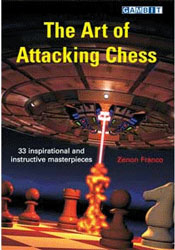
The Art of Attacking Chess; Zenon Franco (trans. by Phil Adams); 256 pages; Gambit 2008
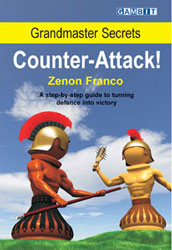
Grandmaster Secrets: Counter-Attack! ; Zenon Franco (trans. by Manuel Perez Carballo); 224 pages; Gambit 2009
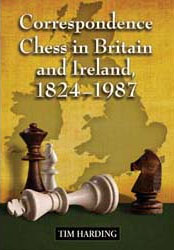
Correspondence Chess in Britain and Ireland, 1824-1987; Tim Harding; 433 pages; McFarland 2011
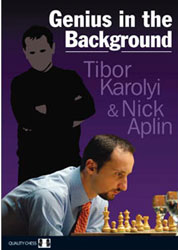
Genius in the Background; Tibor Károlyi and Nick Aplin; 384 pages; Quality Chess 2010

Jose Raul Capablanca, 3rd World Chess Champion; by Isaak and Vladimir Linder; 272 pages; Russell Enterprises 2010
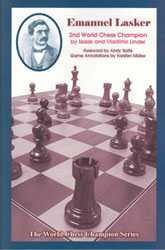
Emanuel Lasker, Second World Chess Champion ; Isaak & Vladimir Linder; 264 pages; Russell 2010
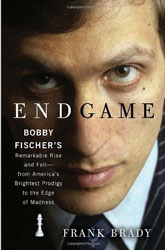
Endgame: Bobby Fischer's Remarkable Rise and Fall - from America's Brightest Prodigy to the Edge of Madness; Frank Brady; 416 pages; Random House 2011

AVRO 1938 International Chess Tournament; Robert Sherwood & Dale Brandreth; 167 pages; Caissa Editions 2010

The Mammoth Book of The World’s Greatest Chess Games , 3rd Edition; Graham Burgess, John Nunn, & John Emms; 704 pages; Constable & Robinson Ltd 2010

For some reason I only very recently got Modern Chess: Move by Move by Colin Crouch and therefore haven't spent as much time with it as I intend to. My first impression is quite positive. This is another book which tries to help the reader understand 'every' move; you might consider this a bit of a gimmick, but it's a way of encouraging players that all chess moves make some sort of sense. I imagine the material would best fit developing players from 1000-1800; most of it is of average difficulty, even though some of the first games explain elementary considerations of the very first moves, whereas the dense technical detail in which some middlegame positions are torn apart is probably not too helpful at a sub-master level. In terms of the balance between prose and analysis, I'd say that the treatment is comparable to John Nunn's Understanding Chess Move-by-Move, and of course much denser (far more analysis) than Irving Chernev's Logical Chess Move-by-Move.
I` particularly like the instructive way in which Crouch explains the flow of the game. Frequently he pauses to write a sort of mini-essay about a position, doing so clearly and with originality. He consistently makes insightful comments about what general considerations apply according to the specific type of position, and he often departs from 'objective' factors to explain psychological factors, for example, how difficult it is for one side or another to adjust to new and surprising situations. Finally, he reflects upon general issues, e.g., the relative strengths of players through the ages, rating inflation, and the effect of the faster modern time controls.
The book features 33 games from a four-year period (2005-2008). Its subtitle is 'a step-by-step guide to brilliant chess.' Two major themes are the changes in modern chess and the influence of the computer. In both areas Crouch makes clear what the current situation is, and also provides food for thought. There is more than enough prose to support the early stage of the game which, again, is healthy for the student. Then, at critical stages, the analysis (of moves) often becomes extremely dense and less verbal. That's inevitable, because the majority of these games are heavily tactical, and sometimes Crouch wants to find the absolute truth of positions (he doesn't like to use the word 'unclear'!).
My only reservation so far is that there seems to be so much theory involved in many of the games, that is, Crouch cites other game examples throughout the opening, and they extend well into the contest. Because of this, I sometime get the impression that home analysis rather than 'brilliance' is the most important part of the game. Since an awful lot of these games are tactical slugfests, they may even have been worked out at home to decisive positions after an innovation. In Games 1-20, for example, I saw first new moves that came on moves 17, 18, 15, 19, 19, 22, 22, 15, 22, 18, 20, and 16; and there are later games cited after that point which the reader would have to know in order to play the particular variation being used. This brings up two issues. First, readers/students usually like to think that they themselves could realistically play the opening of a game they are studying which has so much opening material; but the notes (citing nuances from very high-level contests) give the impression that you would have to know a huge amount of material, and keep up with latest developments, merely in order to play the opening without one slip being fatal. Secondly, having so many citations and notes to play through might be discouraging for the lower players, whom I assume are the one of the primary audience for this book. They may end up feeling that chess consists to a large extent of uncreative preparation bordering upon drudgery, something I don't think is true for most of modern practice (that is, games which are not so theory-dependent and tactically critical).
I don't want to exaggerate this concern, however. There are plenty of creative games which deviate from theory at an early stage, to which the above description doesn't apply. And although I don't think there are as many games of a positional nature as you might expect in a move-by-move book, there is a solid selection of them, as well as a number of instructive endgames. Furthermore, for all the space I just consumed in worrying about it, some people might consider the presence of a lot of theory an advantage! Perhaps this merely shifts my initial estimate of the ideal audience's strength upwards a few hundred points. In any case, it would be unfair to leave the wrong impression; I've included this book because I'm impressed with its concept and execution. Modern Chess: Move by Move should be judged by Crouch's exposition of the chess ideas that underlie individual moves. From what I have read, he does that extremely well, and the book is pleasantly enhanced by his general reflections on the game.

Speaking of collections of master games, I neglected two excellent representatives of the genre when they first appeared: Zenon Franco's The Art of Attacking Chess and Grandmaster Secrets: Counter-Attack!. There are plenty of books on attack and defence, but these are annotated games collections like Crouch's, and both emphasise instruction and analysis. The Art of Attacking Chess has 33 main games and assorted 'supplementary games'. The latter illustrate the themes of the main game; they are annotated, but less thoroughly. The book also includes 73 exercises. It is officially divided into six chapters:
1) The King in the Centre
2) Opposite-Side Castling
3) Attacking the Castled King (Same-Side Castling)
4) Exploiting Temporary Advantages
5) Horwitz Bishops
6) Miscellaneous Themes
The Power of the f5 Knight
Manoeuvring with the Major Pieces
The Pawn-centre
I don't generally have time to read games collections, but happened to return to this one repeatedly for instructional material for my students. Franco's games selection is great for this purpose, with a good mix of prose and analysis; each game is followed by a summary of the main points. In fact, the games (mostly modern, with only a few of them classics) generally contain several clear positional and tactical themes, not limited by the chapter topic. And sometimes the theme is expanded; for example, in the definition of Horwitz Bishops, Franco liberally includes bishops of b2 and d3 (or b7 and d6) when the bishop on b2(b7) is blocked by a pawn on d4(d5)! The associated games are useful, because they illustrate frequently-arising positions which are almost never discussed elsewhere. Finally, quite aside from its instructional value, The Art of Attacking Chess serves as a well-chosen collection of exciting games.

The same can be said of Franco's book Grandmaster Secrets: Counter-Attack!. It is a sort of complementary volume, in which the attacks are now in the nature of a defensive action taken to defuse or refute the opponent's attack. The term 'counter-attack' is used liberally, sometime only meaning that there is an 'attack' against one's centre to which one must respond actively. Also, the steps being taken are sometimes more in the nature of defence than counter-attack. At any rate, the chapters are named as follows:
1 Lasker, the Master of
Defence and Counterattack
2 Refuting Premature Attacks
3
Fighting Blow by Blow
4 Regrouping
5 Prophylactic Thinking
6
Simplification
7 Three Memorable Struggles
Most of this is fairly self-evident, with techniques ranging from simplification, counter-sacrifices, preventative moves, and simply active defence. Interestingly, the 'three memorable struggles' in the last chapter are all draws. There, again, the concept of 'counter-attack' is stretched a bit thin; basically these are simply very hard-fought games, and fascinating ones at that. Two of them end in deep and instructive endgames: Browne-Fischer, Rovinj/Zagreb 1970 (a surprisingly neglected game) and Szabo-Botvinnik, Budapest 1952.
The book structure is roughly the same as above: introductions, game summaries, and 58 exercises (with seven 'additional exercises'). It has plenty of explanatory prose, and I can recommend it to anyone with moderate experience (perhaps 1400 and above).

Correspondence Chess in Britain and Ireland, 1824-1987 is a version of Tim Harding's Ph.D thesis, with which he received his degree in History from University of Dublin. It covers a huge range of material, some probably not appealing to the modern active player, but mostly geared towards those with a special interest in correspondence chess, chess history, and/or British and Irish social history. Harding covers the history of British and Irish correspondence chess from the first formal match between Edinburgh and London in 1824. The volume includes 53 photographs, many of the familiar black-and-white-grainy-portrait variety; some, however, are quite clear and striking. There's a wonderful 'famous' engraving that I'd never seen with Falkbeer, Staunton, Captain H A Kennedy seated together; even I know of the these three giants of British chess, whereas G W Lytellton, also pictured, was apparently a patron of the game. Harding includes many games - he is well-known among authors for his massive Ultra-Corr database - and has made a database of 4000 games from 1914 alone, mostly by British players!
I suppose that it's pretty obvious to whom this book will appeal. In any case, here is the Table of Contents:
Preface
and Acknowledgments
1
Abbreviations 6
Annotation
Symbols 6
1. Capital Letters:
Edinburgh versus London, 1824–1828
7
2. Heyday of the Inter-Club Matches
28
3. Penny Post and Private Matches
50
4. Moves Over the Wires: Chess Adopts Technology
64
5. The Earliest Postal Tournaments, 1853 to 1870
78
6. Changing Times: The 1870s and 1880s
95
7. “A Battle at Long Range”: The United Kingdom
versus the United States, 1877–1881
114
8. The Growth of Tournaments, 1870 to 1897
127
9. Scottish Correspondence Chess to 1918
161
10. Irish and Welsh Correspondence Chess to 1918
177
11. The English Scene, 1890 to 1918
195
12. From One War to the Next, 1918 to 1939
222
13. Correspondence Chess During World War II
246
14. International Revival, 1946 to 1951
261
15. Domestic Competitions, 1946 to 1970
273
16. Crisis and Resolution: Britain and the
International
Correspondence Chess Federation, 1951 to 1971
294
17. The Home Front: The 1970s and 1980s
308
18. Growth and Success, 1972 to 1982
330
19. Becoming World Champions
343
Appendix I. Matches Between Clubs
355
Appendix II. Lists of Champions
365
Appendix III. Excerpts from Rules and Other Documents
375
Appendix IV. British and Irish Holders of I.C.C.F. Titles
386
Chapter Notes 389
Select
Bibliography 409
Index of
Images 413
Index of Opponents
413
Index of Openings by Name
415
Index of Openings by ECO Code
415
General Index 416
At this point, I've come down to books which I really haven't read enough of to comment upon intelligently. But I feel these should be mentioned/described because of their obvious quality. Here goes:

Tibor Károlyi and Nick Aplin's Genius in the Background is an utterly unique project. To quote from the website:
"Genius in the Background introduces brilliant chess that will be unfamiliar to even well-read chessplayers. Twelve chess stars are profiled with examples of their greatest achievements, but these stars are not famous – they are geniuses who stay in the background. For example, Pervakov and Afek are not household names but they compose chess studies and puzzles of such elegance and cleverness that they deserve to be famous. Top players such as Garry Kasparov and Veselin Topalov may be famous names to chess fans, but they did not become World Champions without great help – two of their coaches are profiled in this book and provide insights into the education of a chess champion. A broad range of chess is covered by the twelve profiles – from openings to endgames, puzzles to training. The common thread is beauty and brilliance that deserves to be better known."
Two of the trainers featured are: Petko Atanasov, who trained Topalov, and Alexander Sakharov, who trained Kasparov as a Junior. As a writer, I am extremely familiar with Elmar Maggeramov, although I never knew that he had more wins against Kasparov with a classical time control than Anand or Gulko or Topalov (assuming that the book is right and that they all have three wins versus Kasparov, and Maggeramov has four)!
In order to sample the book, I read Karolyi's generous tribute to his deceased friend Karoly Honfi, since Honfi was relatively famous when I was growing up. It's a terrific chapter with some great chess. The chapter on Gerardo Barbero, who died young, was similarly motivated.
The Introduction is entirely by Karolyi, and he only mentions Nick Aplin once, as his 'co-author'. Even after searching the web, I can't discover which parts each did or what role they had, except that most of the subjects were personal acquaintances of Karolyi. Aplin, who coaches in Singapore, presumably wrote the chapter on Singapore! I'm also surprised that the number of games isn't mentioned; at a glance (of the Index), it appears to be about 100 (I don't know how many are fragments). There are even some early games by Topalov and Kasparov that are previously unpublished!
Only the inclusion of Karsten Müller is strange - he's extremely well-known throughout the chess world (not only does he have numerous successful books and DVDs to his credit, and not only does he writes for ChessBase and several publications, but he has been on my ChessFM show twice! See Review Column #97). That's not a criticism, and it certainly doesn't hurt the book - it's just interesting that Karolyi's perspective on the chess world is apparently isolated from the West.
Russell Enterprises has published two books about World Champions, both written by Isaak and Vladimir Linder (as co-authors). They are part of "The World Chess Champions Series", which according to Averbach is a revised and reworked version of a 1000+ page Russian work called Chess Kings. The series is meant to run to 14-volumes; if true, and judging from the first two volumes, the biographical description will be an enormous improvement upon the popular history given in Kasparov's Predecessors series.

The first volume is Jose Raul Capablanca, 3rd World Chess Champion, which has all kinds of new research and tidbits about Capablanca's life and career, including correspondence and new accounts unpublished in English about famous tournaments. I found the extensive Bibliography very impressive.
The book's emphasis is biographical, although there are 87 illustrative games/fragments. These have very limited analysis, but considerable verbal commentary. Not surprisingly, there are a number of what the authors call 'myths' about Capablanca, e.g., that he didn't study of the game seriously. It is fascinating that he was still working hard to prepare openings in 1935 in hope of a match against Alekhine, and that even as late as the year of his death (1942), he still expected to play for the Championship (in fact, receiving a report that Alekhine, freed from confinement, was in Portugal and prepared to play the match).
Without having read enough of Jose Raul Capablanca, I can only say that I definitely plan to do so in the future.

Similarly, the Linders' Emanuel Lasker, Second World Chess Champion emphasises the World Champion's biography more than his games. Of course, there's enough biographical material associated with this man's long and full life to fill several volumes. In his Introduction, Andy Soltis says, "This book is arguably the finest work of chess history in more than 30 years." That comes from someone who has written a book about Lasker (concentrating upon his games and style, to be sure), and in the presence of the recent massive Emanuel Lasker: Denker, Weltbürger, Schachweltmeister. Again, the Bibliography is itself fun to read.
This time the authors invited Karsten Müller (the very same 'Genius in the Background' above) to annotate some of Lasker's games, which undoubtedly adds value to the chessic part of the book. As above, I'm looking forward to reading Emanuel Lasker, Second World Chess Champion, and will probably do so even before Capablanca.

Three last-minute items. First, two particularly attractive hardback books have just arrived on my doorstep and deserve a brief mention before I send this off. The first is Frank Brady's Endgame: Bobby Fischer's Remarkable Rise and Fall - from America's Brightest Prodigy to the Edge of Madness. I recently had Brady on my ChessFM interview show and had unfortunately only read excerpts of the book. This is a complete autobiography, with only a portion repeated from Brady's famous Profile of a Prodigy, and everything revised and rewritten based upon Brady's research over the last 40 years.
This is the definitive biography (so far!) and every Fischer fan will obviously want to read and discuss it. In the interview, I learned about a few of the findings/discoveries that Brady made which previous chroniclers and researchers didn't have access to. They include some of Fischer's emails, an autobiographical essay that Fischer wrote in his teens, a number of FBI files, and many papers from both Jack Collins' collection and what Brady calls the 'Fischer family archives'.

The other recent arrival (yesterday!) is AVRO 1938 International Chess Tournament by Robert Sherwood and Dale Brandreth. This is another fine contribution to chess literature by Caissa Editions; remarkably, there hasn't been a book in English devoted to AVRO 1938, in spite of the fact that it is one of the most famous tournaments in chess history. The Bibliography lists only one other work on the tournament, Euwe's book in Dutch.
It's always good to have more tournament books out there, and AVRO was of considerable historical importance. It was a double round-robin among the world's best players at the time: Alekhine, Capablanca, Euwe, Botvinnik, Keres, Fine, Reshevsky and Flohr, with Keres and Fine. All the games are fully annotated (and of course computer checked) by Bob Sherwood. Dale Brandreth sets the historical stage and supplies the research (including funny anecdotes). In the front, he has a 22-page section of games between the participants which had been played in the previous two years, with notes. At the end of the book, Brandreth's entertaining essay 'AVRO-the Results Analysed' contains some assessments of the players, with a few statistics; and his essay 'After AVRO' includes short interviews with Capabalanca (with his wife), Keres, and Alekhine. Obviously chess history buffs and book collectors will form a core audience for AVRO 1938, and hopefully there are players and students who will put aside some time to study fascinating games by the old masters

Finally, I just received the 3rd Edition of The Mammoth Book of The World’s Greatest Chess Games , the classic collection by Graham Burgess, John Nunn, & John Emms. To quote the authors: " The aim of this book is simple: to present the 125 greatest chess games of all time, with annotations that enable chess enthusiasts to derive the maximum enjoyment and instruction from them." For the famous games which appear in other books and anthologies, the authors have provided the most thorough and careful annotations you will find. They also include some extremely brilliant games which haven't received much attention elsewhere.
This edition expands upon the previous one; it has 704 pages(!), with 13 new games from 2003 to 2010, ending with Anand-Topalov World Ch (4), Sofia 2010. The earlier games have been reanalysed, with new assessments, and there are various revisions such as new player biographies (11 players had died!). For each game, there are sections called: ' The Players', introducing the players; 'The Game' (this includes the context of the game and/or a description of its course); and 'Lessons from this game'. Of the various 'Greatest Games' collections, The Mammoth Book of The World’s Greatest Chess Games is the most up to date with the highest-quality annotations. You will want a copy on your shelf.


 TWIC is 29. First issue 17th September 1994.
TWIC is 29. First issue 17th September 1994.





